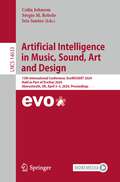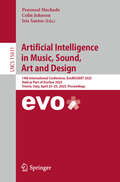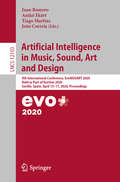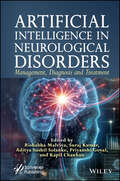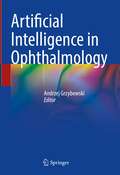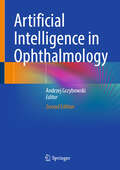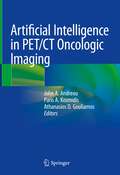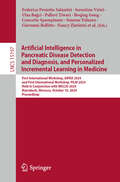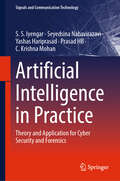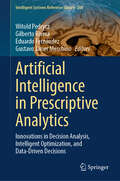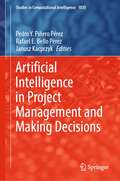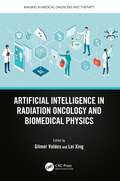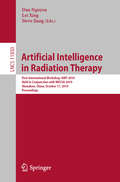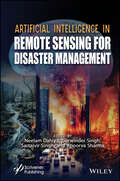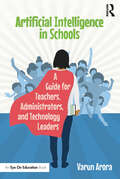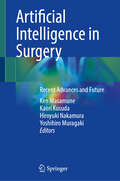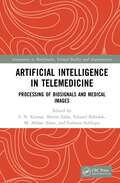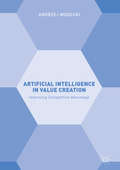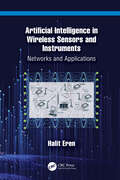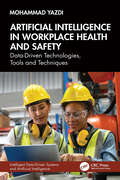- Table View
- List View
Artificial Intelligence in Music, Sound, Art and Design: 13th International Conference, EvoMUSART 2024, Held as Part of EvoStar 2024, Aberystwyth, UK, April 3–5, 2024, Proceedings (Lecture Notes in Computer Science #14633)
by Colin Johnson Sérgio M. Rebelo Iria SantosThis book constitutes the refereed proceedings of the 13th International Conference on Artificial Intelligence in Music, Sound, Art and Design, EvoMUSART 2024, held as part of EvoStar 2024, in Aberystwyth, UK, April 3–5, 2024. The 17 full papers and 8 short papers presented in this book were carefully reviewed and selected from 55 submissions. The main purpose of this conference proceedings was to bring together practitioners who are using Artificial Intelligence techniques for artistic tasks, providing the opportunity to promote, present, and discuss ongoing work in the area.
Artificial Intelligence in Music, Sound, Art and Design: 14th International Conference, EvoMUSART 2025, Held as Part of EvoStar 2025, Trieste, Italy, April 23–25, 2025, Proceedings (Lecture Notes in Computer Science #15611)
by Penousal Machado Colin Johnson Iria SantosThis book constitutes the refereed proceedings of the 14th International Conference on Artificial Intelligence in Music, Sound, Art and Design, EvoMUSART 2025, held as part of EvoStar 2025, in Trieste, Itlay, during April 23–25, 2024. The 28 full papers presented in this book were carefully reviewed and selected from 52 submissions. They present a broad selection of topics and applications, including systems that create music, art, and design.
Artificial Intelligence in Music, Sound, Art and Design: 9th International Conference, EvoMUSART 2020, Held as Part of EvoStar 2020, Seville, Spain, April 15–17, 2020, Proceedings (Lecture Notes in Computer Science #12103)
by João Correia Anikó Ekárt Juan Romero Tiago MartinsThis book constitutes the refereed proceedings of the 9th European Conference on Artificial Intelligence in Music, Sound, Art and Design, EvoMUSART 2020, held as part of Evo*2020, in Seville, Spain, in April 2020, co-located with the Evo*2020 events EuroGP, EvoCOP and EvoApplications.The 15 revised full papers presented were carefully reviewed and selected from 31 submissions. The papers cover a wide spectrum of topics and application areas, including generative approaches to music and visual art, deep learning, and architecture.
Artificial Intelligence in Neurological Disorders: Management, Diagnosis and Treatment
by Suraj Kumar Rishabha Malviya Priyanshi Goyal Aditya Sushil Solanke Kapil ChauhanThe book gives invaluable insights into how artificial intelligence is revolutionizing the management and treatment of neurological disorders, empowering you to stay ahead in the rapidly evolving landscape of healthcare. Embark on a groundbreaking exploration of the intersection between cutting-edge technology and the intricate complexities of neurological disorders. Artificial Intelligence in Neurological Disorders: Management, Diagnosis and Treatment comprehensively introduces how artificial intelligence is becoming a vital ally in neurology, offering unprecedented advancements in management, diagnosis, and treatment. As the digital age converges with medical expertise, this book unveils a comprehensive roadmap for leveraging artificial intelligence to revolutionize neurological healthcare. Delve into the core principles that underpin AI applications in the field by exploring intricate algorithms that enhance the precision of diagnosis and how machine learning not only refines the understanding of neurological disorders but also paves the way for personalized treatment strategies tailored to individual patient needs. With compelling case studies and real-world examples, the realms of neuroscience and artificial intelligence converge, illustrating the symbiotic relationship that holds the promise of transforming patient care. Readers of this book will find it: Provides future perspectives on advancing artificial intelligence applications in neurological disorders;Focuses on the role of AI in diagnostics, delving into how advanced algorithms and machine learning techniques contribute to more accurate and timely diagnosis of neurological disorders;Emphasizes practical integration of AI tools into clinical practice, offering insights into how healthcare professionals can leverage AI technology for more effective patient care;Recognizes the interdisciplinary nature of neurology and AI, bridging the gap between these fields, making it accessible to healthcare professionals, researchers, and technologists;Addresses the ethical implications of AI in healthcare, exploring issues such as data privacy, bias, and the responsible deployment of AI technologies in the neurological domain. Audience Researchers, scientists, industrialists, faculty members, healthcare professionals, hospital management, biomedical industrialists, engineers, and IT professionals interested in studying the intersection of AI and neurology.
Artificial Intelligence in Ophthalmology
by Andrzej GrzybowskiThis book provides a wide-ranging overview of artificial intelligence (AI), machine learning (ML) and deep learning (DL) algorithms in ophthalmology. Expertly written chapters examine AI in age-related macular degeneration, glaucoma, retinopathy of prematurity and diabetic retinopathy screening. AI perspectives, systems and limitations are all carefully assessed throughout the book as well as the technical aspects of DL systems for retinal diseases including the application of Google DeepMind, the Singapore algorithm, and the Johns Hopkins algorithm. Artificial Intelligence in Ophthalmology meets the need for a resource that reviews the benefits and pitfalls of AI, ML and DL in ophthalmology. Ophthalmologists, optometrists, eye-care workers, neurologists, cardiologists, internal medicine specialists, AI engineers and IT specialists with an interest in how AI can help with early diagnosis and monitoring treatment in ophthalmic patients will find this book to be an indispensable guide to an evolving area of healthcare technology.
Artificial Intelligence in Ophthalmology
by Andrzej GrzybowskiThis book provides a wide-ranging overview of artificial intelligence (AI), machine learning (ML) and deep learning (DL) algorithms in ophthalmology. Expertly written chapters examine AI in age-related macular degeneration, glaucoma, retinopathy of prematurity and diabetic retinopathy screening. AI perspectives, systems and limitations are all carefully assessed throughout the book as well as the technical aspects of DL systems for retinal diseases including the application of Google DeepMind, the Singapore algorithm, and the Johns Hopkins algorithm. Artificial Intelligence in Ophthalmology, 2nd edition has been fully revised with the latest advancements in the field. New chapters highlight topics such as the threats to the validity of the predictive system performance for ophthalmology, challenges in the deployment of AI for diabetic retinopathy screening and the use of AI in calculating the IOL power to name just a few. This book meets the need for a resource that reviews the benefits and pitfalls of AI, ML and DL in ophthalmology. Ophthalmologists, optometrists, eye-care workers, neurologists, cardiologists, internal medicine specialists, AI engineers and IT specialists with an interest in how AI can help with early diagnosis and monitoring treatment in ophthalmic patients will find this book to be an indispensable guide to an evolving area of healthcare technology.
Artificial Intelligence in Orthopaedic Surgery Made Easy
by Filippo Familiari Olimpio Galasso Giorgio GaspariniThis book is an essential reference guide for the use of artificial intelligence in orthopaedic surgery. It covers all related topics, from machine and deep learning, through practical applications in all orthopaedic sub-disciplines, to ethical issues and potential risks. International renowned experts equip the reader with solid scientific foundations and practical tips combining accurate literature reviews with high-quality original images. Addressing a hot topic for the present and next generation of medical specialists, this book is a must read for orthopaedic surgeons, radiologists and health informatic specialists alike.
Artificial Intelligence in PET/CT Oncologic Imaging
by Athanasios D. Gouliamos John A. Andreou Paris A. KosmidisThis book presents artificial intelligence applications that may help in detecting disease, defining tissue characterization (benign vs malignant), staging and correlation with molecular biomarkers. Originally positioned as a means for noninvasive molecular phenotyping and quantification in the 1970s, PET's technological improvements in the 2000s generated renewed interest in quantification, which has grown over the last five years. This progress is parallel with the development of Artificial intelligence (AI) systems for Oncology which aim at providing the best possible treatment to patients suffering from lung, breast, brain, prostate, liver and other types of cancer. The chapters provide an overview of the use of AI in PET/CT imaging for various types of cancer, and it will be an invaluable tool especially for nuclear medicine physicians and oncologists.
Artificial Intelligence in Pancreatic Disease Detection and Diagnosis, and Personalized Incremental Learning in Medicine: First International Workshop, AIPAD 2024 and First International Workshop, PILM 2024, Held in Conjunction with MICCAI 2024, Marrakesh, Morocco, October 10, 2024, Proceedings (Lecture Notes in Computer Science #15197)
by Serestina Viriri Cecilia S. Lee Pallavi Tiwari Federica Proietto Salanitri Ulaş Bağcı Boqing Gong Concetto Spampinato Simone Palazzo Giovanni Bellitto Nancy Zlatintsi Panagiotis Filntisis Aaron Y. LeeThis volume constitutes the refereed proceedings of the First International Workshop on Artificial Intelligence in Pancreatic Disease Detection and Diagnosis, AIPAD 2024 and the First International Workshop on Personalized Incremental Learning in Medicine, PILM 2024, held in conjunction with MICCAI 2024, in Marrakesh, Morocco, in October 2024. The 8 full papers included in these proceedings were carefully reviewed and selected from 9 submissions. They were organized in topical sections as follows: artificial intelligence in pancreatic disease detection and diagnosis; and personalized incremental learning in medicine.
Artificial Intelligence in Practice: Theory and Application for Cyber Security and Forensics (Signals and Communication Technology)
by S.S. Iyengar Seyedsina Nabavirazavi Yashas Hariprasad Prasad HB C. Krishna MohanThis book provides a comprehensive exploration of how Artificial Intelligence (AI) is being applied in the fields of cyber security and digital forensics. The book delves into the cutting-edge techniques that are reshaping the way we protect and investigate digital information. From identifying cyber threats in real-time to uncovering hidden evidence in complex digital cases, this book offers practical insights and real-world examples. Whether you&’re a professional in the field or simply interested in understanding how AI is revolutionizing digital security, this book will guide you through the latest advancements and their implications for the future. Includes application of AI in solving real cyber security and digital forensics challenges, offering tangible examples; Shows how AI methods from machine / deep learning to NLP can be used for cyber defenses and in forensic investigations; Explores emerging trends and future possibilities, helping readers stay ahead of the curve in a rapidly evolving field.
Artificial Intelligence in Prescriptive Analytics: Innovations in Decision Analysis, Intelligent Optimization, and Data-Driven Decisions (Intelligent Systems Reference Library #260)
by Witold Pedrycz Eduardo Fernández Gilberto Rivera Gustavo Javier MeschinoConsidering the advances of the different approaches and applications in the last years, and even in the last months, this is a particular moment in history to transform every data-driven decision-making process with the power of Artificial Intelligence (AI). This book reveals, through concrete case studies and original application ideas, how cutting-edge AI techniques are revolutionizing industries such as finance, health care, and manufacturing. It invites us to discover how machine learning, decision analysis, and intelligent optimization are changing, directly or indirectly, almost all aspects of our daily lives. This comprehensive book offers practical insights and real-world applications for professionals, researchers, and students alike. It helps to learn how to apply AI for smarter, data-driven decisions in areas like supply chain management, risk assessment, and even personalized medicine. Be inspired by the chapters of this book and unlock the full potential of AI in your field!
Artificial Intelligence in Project Management and Making Decisions (Studies in Computational Intelligence #1035)
by Janusz Kacprzyk Pedro Y. Piñero Pérez Rafael E. Bello PérezThis book presents new developments and advances in the theory, applications, and design methods of computational intelligence, integrated in various areas of project management and BIM environments. The chapters of the book span different soft computing techniques, such as: linguistic data summarization, fuzzy systems, evolutionary algorithms, estimation distribution algorithms, computing with words, augmented reality, and hybrid intelligence systems. In addition, different applications of the neutrosophic theory are presented for the treatment of uncertainty and indeterminacy in decision-making processes. Several chapters of the book constitute systematic reviews, useful for future investigations in the following topics: linguistic summarization of data, augmented reality, and the development of BIM technologies. It is a particularly interesting book for engineers, researchers, specialists, teachers, and students related to project management and the development of BIM technologies.
Artificial Intelligence in Radiation Oncology and Biomedical Physics (Imaging in Medical Diagnosis and Therapy)
by Lei Xing Gilmer ValdesThis pioneering book explores how machine learning and other AI techniques impact millions of cancer patients who benefit from ionizing radiation. It features contributions from global researchers and clinicians, focusing on the clinical applications of machine learning for medical physics. AI and machine learning have attracted much recent attention and are being increasingly adopted in medicine, with many clinical components and commercial software including aspects of machine learning integration. General principles and important techniques in machine learning are introduced, followed by discussion of clinical applications, particularly in radiomics, outcome prediction, registration and segmentation, treatment planning, quality assurance, image processing, and clinical decision-making. Finally, a futuristic look at the role of AI in radiation oncology is provided. This book brings medical physicists and radiation oncologists up to date with the most novel applications of machine learning to medical physics. Practitioners will appreciate the insightful discussions and detailed descriptions in each chapter. Its emphasis on clinical applications reaches a wide audience within the medical physics profession.
Artificial Intelligence in Radiation Therapy: First International Workshop, AIRT 2019, Held in Conjunction with MICCAI 2019, Shenzhen, China, October 17, 2019, Proceedings (Lecture Notes in Computer Science #11850)
by Lei Xing Dan Nguyen Steve JiangThis book constitutes the refereed proceedings of the First International Workshop on Connectomics in Artificial Intelligence in Radiation Therapy, AIRT 2019, held in conjunction with MICCAI 2019 in Shenzhen, China, in October 2019.The 20 full papers presented were carefully reviewed and selected from 24 submissions. The papers discuss the state of radiation therapy, the state of AI and related technologies, and hope to find a pathway to revolutionizing the field to ultimately improve cancer patient outcome and quality of life.
Artificial Intelligence in Remote Sensing for Disaster Management
by Gurwinder Singh Neelam Dahiya Sartajvir Singh Apoorva SharmaInvest in Artificial Intelligence in Remote Sensing for Disaster Management to gain invaluable insights into cutting-edge AI technologies and their transformative role in effectively monitoring and managing natural disasters. Artificial Intelligence in Remote Sensing for Disaster Management examines the involvement of advanced tools and technologies such as Artificial Intelligence in disaster management with remote sensing. Remote sensing offers cost-effective, quick assessments and responses to natural disasters. In the past few years, many advances have been made in the monitoring and mapping of natural disasters with the integration of AI in remote sensing. This volume focuses on AI-driven observations of various natural disasters including landslides, snow avalanches, flash floods, glacial lake outburst floods, and earthquakes. There is currently a need for sustainable development, near real-time monitoring, forecasting, prediction, and management of natural resources, flash floods, sea-ice melt, cyclones, forestry, and climate changes. This book will provide essential guidance regarding AI-driven algorithms specifically developed for disaster management to meet the requirements of emerging applications.
Artificial Intelligence in Renewable Energetic Systems: Smart Sustainable Energy Systems (Lecture Notes In Networks And Systems #35)
by Mustapha HattiThis book includes the latest research presented at the International Conference on Artificial Intelligence in Renewable Energetic Systems held in Tipaza, Algeria on October 22–24, 2017. The development of renewable energy at low cost must necessarily involve the intelligent optimization of energy flows and the intelligent balancing of production, consumption and energy storage. Intelligence is distributed at all levels and allows information to be processed to optimize energy flows according to constraints. This thematic is shaping the outlines of future economies of and offers the possibility of transforming society. Taking advantage of the growing power of the microprocessor makes the complexity of renewable energy systems accessible, especially since the algorithms of artificial intelligence make it possible to take relevant decisions or even reveal unsuspected trends in the management and optimization of renewable energy flows. The book enables those working on energy systems and those dealing with models of artificial intelligence to combine their knowledge and their intellectual potential for the benefit of the scientific community and humanity.
Artificial Intelligence in Schools: A Guide for Teachers, Administrators, and Technology Leaders
by Varun AroraArtificial Intelligence in Schools is the first book to explore the use of Artificial Intelligence (AI) as a tool to enhance K–12 instruction and administration. Every industry and sector will be drastically affected by the presence of artificial intelligence, and schooling is no exception! Written for the in-service community—leaders, administrators, coaches, and teachers alike—this is your one-stop opportunity to make sure you don’t fall behind the fast pace and promising innovations of today’s most advanced learning technology. Author Varun Arora presents AI as a problem-solving tool for teaching and learning, exploring its potential and application in real-world school contexts and in the language of educators. Covering curriculum development, feedback and scoring, student empowerment, behavioral and classroom management, college readiness, and more, the book is full of novel insights and concrete, strategic takeaways.
Artificial Intelligence in Sport Performance Analysis
by Keith Davids Duarte Araújo Ludovic Seifert Micael S Couceiro Hugo SarmentoTo understand the dynamic patterns of behaviours and interactions between athletes that characterize successful performance in different sports is an important challenge for all sport practitioners. This book guides the reader in understanding how an ecological dynamics framework for use of artificial intelligence (AI) can be implemented to interpret sport performance and the design of practice contexts. By examining how AI methodologies are utilized in team games, such as football, as well as in individual sports, such as golf and climbing, this book provides a better understanding of the kinematic and physiological indicators that might better capture athletic performance by looking at the current state-of-the-art AI approaches. Artificial Intelligence in Sport Performance Analysis provides an all-encompassing perspective in an innovative approach that signals practical applications for both academics and practitioners in the fields of coaching, sports analysis, and sport science, as well as related subjects such as engineering, computer and data science, and statistics.
Artificial Intelligence in Surgery: Recent Advances and Future
by Hiroyuki Nakamura Ken Masamune Kaori Kusuda Yoshihiro MuragakiThis book provides an in-depth look into the transformative world of AI Surgery, offering a detailed examination of its recent advances and future potential. Beginning with a clear definition and classification of "AI Surgery," the book sets the stage for understanding how artificial intelligence is reshaping surgical practices. It addresses the pressing need for data standardization and cybersecurity, crucial for the effective implementation of AI in medical environments. The chapters cover a wide range of topics, including the development of Smart Cyber Operating Theaters and the intricacies of surgical process and semantic data modeling. The book also tackles regulatory and ethical issues, providing a comprehensive overview of the challenges faced by AI Surgery. Real-world clinical cases in neurosurgery, orthopedic surgery, eye surgery, and laparoscopic surgery illustrate the practical applications of AI, while future trends such as AI-driven robotics, telesurgery using 5G, and AI-enhanced theranostics are explored in detail. Readers will find contributions from leading experts in the field, offering diverse perspectives and insights. The book invites readers to consider critical questions about the future of surgery and the role of AI in enhancing surgical outcomes. It is a vital resource for medical engineers, AI researchers, and medical doctors interested in cutting-edge medical technologies. It serves as a foundation for future advancements in AI Surgery, making it an essential read for professionals seeking to understand and contribute to the future of surgical innovation.
Artificial Intelligence in Telemedicine: Processing of Biosignals and Medical images (Innovations in Multimedia, Virtual Reality and Augmentation)
by Sherin Zafar M. Afshar Alam S. N. Kumar Eduard Babulak Farheen SiddiquiThis book explores the role of artificial Intelligence in Telemedicine. It explains the concepts through the detailed study and processing of biosignals, physiological parameters, and medical images. The book focuses on computational algorithms in telemedicine for the processing of biosignals, physiological parameters, and medical Images. The book is presented in two section. The first section presents the role of computational algorithms in the processing of biosignal and medical images for disease diagnosis and treatment planning. Noise removal in ECG signal using an improved adaptive learning approach, classification of ECG signals using CNN for cardiac arrhythmia detection, EEG signal analysis for stroke detection, and EMG signal analysis for gesture classification were discussed in this section. Application of CNN in pertussis Diagnosis by temperature monitoring, physician handwriting recognition using deep learning model, melanoma detection using ABCD parameters, and transfer learning enabled heuristic approach for pneumonia detection was also discussed in this section The second section focus on the role of IoT and artificial intelligence in the healthcare sector. IoT in smart health care and applications of artificial intelligence in disease diagnosis and prediction was discussed in this section. The importance of 5G/6G in the pandemic scenario for telemedicine applications, wireless capsule endoscopy image compression, leukemia detection from the microscopic cell images, and genomic signal processing using numerical mapping techniques was also discussed in this section. This book can be used by a wide range of users including students, research scholars, faculty, and practitioners in the field of engineering for applications in biomedical signal, image analysis, and diagnosis.
Artificial Intelligence in Value Creation: Improving Competitive Advantage
by Andrzej WodeckiThis book analyses various models of value creation in projects and businesses by applying different forms of Artificial Intelligence in their products and services. First presenting the main concepts and ideas behind AI, Wodecki assesses different models of technology-based value creation based upon the analysis of over 400 case studies. This framework shows how AI may influence both value creation and competitive advantage (efficiency, creativity and flexibility) within a modern organization. Finally, a conceptual model is formulated to evaluate AI-supported in-company projects and new ventures and identify the key managerial and technical competencies required.
Artificial Intelligence in Vision-Based Structural Health Monitoring (Synthesis Lectures on Mechanical Engineering)
by Khalid M. Mosalam Yuqing GaoThis book provides a comprehensive coverage of the state-of-the-art artificial intelligence (AI) technologies in vision-based structural health monitoring (SHM). In this data explosion epoch, AI-aided SHM and rapid damage assessment after natural hazards have become of great interest in civil and structural engineering, where using machine and deep learning in vision-based SHM brings new research direction. As researchers begin to apply these concepts to the structural engineering domain, especially in SHM, several critical scientific questions need to be addressed: (1) What can AI solve for the SHM problems? (2) What are the relevant AI technologies? (3) What is the effectiveness of the AI approaches in vision-based SHM? (4) How to improve the adaptability of the AI approaches for practical projects? (5) How to build a resilient AI-aided disaster prevention system making use of the vision-based SHM? This book introduces and implements the state-of-the-art machine learning and deep learning technologies for vision-based SHM applications. Specifically, corresponding to the above-mentioned scientific questions, it consists of: (1) motivation, background & progress of AI-aided vision-based SHM, (2) fundamentals of machine learning & deep learning approaches, (3) basic AI applications in vision-based SHM, (4) advanced topics & approaches, and (5) resilient AI-aided applications. In the introduction, a brief coverage about the development progress of AI technologies in the vision-based area is presented. It gives the readers the motivations and background of the relevant research. In Part I, basic knowledges of machine and deep learning are introduced, which provide the foundation for the readers irrespective of their background. In Part II, to verify the effectiveness of the AI methods, the key procedure of the typical AI-aided SHM applications (classification, localization, and segmentation) is explored, including vision data collection, data pre-processing,transfer learning-based training mechanism, evaluation, and analysis. In Part III, advanced AI topics, e.g., generative adversarial network, semi-supervised learning, and active learning, are discussed. They aim to address several critical issues in practical projects, e.g., the lack of well-labeled data and imbalanced labels, to improve the adaptability of the AI models. In Part IV, the new concept of “resilient AI” is introduced to establish an intelligent disaster prevention system, multi-modality learning, multi-task learning, and interpretable AI technologies. These advances are aimed towards increasing the robustness and explainability of the AI-enabled SHM system, and ultimately leading to improved resiliency.The scope covered in this book is not only beneficial for education purposes but also is essential for modern industrial applications. The target audience is broad and includes students, engineers, and researchers in civil engineering, statistics, and computer science. Unique Book Features:• Provide a comprehensive review of the rapidly expanding field of vision-based structural health monitoring (SHM) using artificial intelligence approaches. • Re-organize fundamental knowledge specific to the machine and deep learning in vision tasks.• Include comprehensive details about the procedure of conducting AI approaches for vision-based SHM along with examples and exercises.• Cover a vast array of special topics and advanced AI-enabled vision-based SHM applications.• List a few potential extensions for inspiring the readers for future investigation.
Artificial Intelligence in Wireless Robotics (River Publishers Series In Information Science And Technology Ser.)
by Kwang-Cheng ChenRobots, autonomous vehicles, unmanned aerial vehicles, and smart factory, will significantly change human living style in digital society. Artificial Intelligence in Wireless Robotics introduces how wireless communications and networking technology enhances facilitation of artificial intelligence in robotics, which bridges basic multi-disciplinary knowledge among artificial intelligence, wireless communications, computing, and control in robotics. A unique aspect of the book is to introduce applying communication and signal processing techniques to enhance traditional artificial intelligence in robotics and multi-agent systems.The technical contents of this book include fundamental knowledge in robotics, cyber-physical systems, artificial intelligence, statistical decision and Markov decision process, reinforcement learning, state estimation, localization, computer vision and multi-modal data fusion, robot planning, multi-agent systems, networked multi-agent systems, security and robustness of networked robots, and ultra-reliable and low-latency machine-to-machine networking. Examples and exercises are provided for easy and effective comprehension.Engineers wishing to extend knowledge in the robotics, AI, and wireless communications, would be benefited from this book. In the meantime, the book is ready as a textbook for senior undergraduate students or first-year graduate students in electrical engineering, computer engineering, computer science, and general engineering students. The readers of this book shall have basic knowledge in undergraduate probability and linear algebra, and basic programming capability, in order to enjoy deep reading.
Artificial Intelligence in Wireless Sensors and Instruments: Networks and Applications
by Halit ErenThis book heralds a new era in instrumentation and measurements. It combines artificial intelligence (AI) and wireless communications technologies with instrumentation and measurement systems to function as a single unit. AI has advanced considerably due to deep learning utilizing artificial neural networks, availability of large and curated datasets, implementation of a new generation of fast processors having millions of transistors in chips, advanced algorithms, competitive commercial interests, and interests of governments to gain advantages. At the same time, new and highly advanced wireless technologies open new frontiers in communication systems, both technologically and in terms of applications aspects. Advanced technologies such as 5G and 6G networks enable easy use of communication systems by billions of people as well as by billions of machine-to-machine systems.In this book, the communication principles are explained and the implementation of AI on wireless networks is discussed. Many examples are provided. The author discusses instruments and instrumentation networks, modern sensors, and transducers in detail.AI is the technology humans have created where the machines do not only assist us but also think for us creatively in some cases, excelling humans thinking and reasoning. This book includes a chapter explaining how this is done, backed up with more than 50 figures. The security issues, fairness, efficiency, and social impact and acceptance of AI are highlighted. As explained in this book, AI and wireless communications are changing our lives in many ways, including entertainment, games, social interactions, medicine and healthcare, R&D, automated living, intelligent transport systems, finance and economy, and the Internet of Things.
Artificial Intelligence in Workplace Health and Safety: Data-Driven Technologies, Tools and Techniques (Intelligent Data-Driven Systems and Artificial Intelligence)
by Mohammad YazdiIn today's dynamic workplace environment, ensuring the safety and well-being of employees has never been more critical. This book explores cutting-edge technologies intersecting with workplace safety to deliver effective and practical results.Artificial Intelligence in Workplace Health and Safety: Data-Driven Technologies, Tools and Techniques offers a comprehensive roadmap for professionals, researchers, and practitioners in work health and safety (WHS), revolutionizing traditional approaches through the integration of data-driven methodologies and artificial intelligence. Covering the foundations and practical applications of data-driven WHS and historical perspectives to current regulatory frameworks, it investigates the key concepts of data collection, management, and integration. Through real-world case studies and examples, readers can discover how AI technologies such as machine learning, computer vision, and natural language processing are reshaping WHS practices, mitigating risks, and optimizing safety measures. The reader will learn applications of AI and data-driven methodologies in their workplace settings to improve safety. With its practical insights, real-world examples, and progressive approach, this title ensures that readers are not just prepared for the future of WHS but empowered to shape it for better. This text is written for professionals and practitioners seeking to enhance workplace safety through innovative technologies. This extends to safety professionals, HR personnel and engineers across different sectors.
